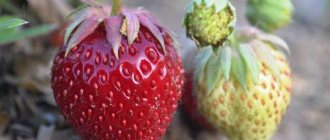History of selection
The strawberry variety Fireworks was obtained by crossing the well-known varieties Zenga Zengana and Redcoat. Selection work took place at the All-Russian Research Institute of Genetics and Selection of Fruit Plants named after. I. V. Michurina. The work was carried out in the nineties of the last century. At this time, the variety was tested and tested at VSTISP. Later, in 2000, Fireworks was officially registered in the State Register of the Russian Federation, according to which it was approved for cultivation in open ground in eastern Siberia, the Black Earth Region, in the Central and Volga-Vyatka regions, as well as in the North Caucasus. After practical application, strawberries of the Firework variety showed good results in the Central regions of the Russian Federation and the Volga region.
Harvest Application
Fireworks strawberries have a universal purpose. They are excellent for fresh consumption, but since the harvest ripens together and its size is rather large, some of the berries have to be processed. Almost anything can be made from them, as long as the housewife's imagination is enough: in addition to traditional jams and compotes, the berries are used to extract juice, make marmalade, and even make wine.
Strawberry wine isn't made often, but the work is worth it.
If you have a good freezer, you can freeze some of the berries: in winter, thawed strawberries will be a little sour, but they will contain all the same nutrients as fresh ones. This is especially true for ascorbic acid, of which there is a lot of Fireworks fruits, and during heat treatment, as is known, it is almost completely destroyed. Unfortunately, strawberries store very poorly, and in order for them to sit for several days, they have to be picked slightly unripe.
Description of the strawberry variety Fireworks
The strawberry bush is powerful, erect, and resembles a ball in shape. The leaves are flat, slightly shiny, dark green in color, medium in size.
The root system is strong, fibrous, branched. Adult plants have a main rhizome and adventitious lateral fibrous roots.
Strawberries of the Firework variety bloom profusely. Not very tall, but quite powerful peduncles are located below the leaves. Despite the large number of inflorescences and berries, they are held in weight. The flowers are white, large, belong to both sexes, for this reason the berry set is high.
The number of whiskers formed is average.
The berries are medium in size - about 13 g. Their shape is round or conical, with a blunt end. The color is bright red, in the stage of full ripeness it is dark red, reaching cherry. The berry pulp of this variety is juicy, dense, fleshy, with a strong aroma, and when cut it is red without inclusions. The taste is rich, sweet and sour. Strawberries contain 7.4% sugar and 1.3% acid. According to the tasters, the Firework variety received 4.8 out of 5 points for taste.
Video
Professional gardeners from the Sumy region (Ukraine) share their opinions about the variety in the following videos:
About the author:
Found a mistake? Select the text with the mouse and click:
Ctrl + Enter
Do you know that:
In Australia, scientists have begun experiments in cloning several varieties of grapes grown in cold regions. Climate warming, which is predicted for the next 50 years, will lead to their disappearance. Australian varieties have excellent characteristics for winemaking and are not susceptible to diseases common in Europe and America.
Characteristics of the variety
Among the main characteristics of the variety are:
- ripening time is average;
- fruiting is not remontant;
- productivity – high;
- purpose – universal;
- resistance to pests and diseases is average.
Main advantages
The description of the Firework strawberry variety, photos and reviews of gardeners about the plant allow us to conclude that it is advisable to grow the crop throughout almost the entire country with a guarantee of obtaining a high yield. Among the advantages and disadvantages are:
- drought resistance;
- winter hardiness;
- high immunity to diseases (gray rot and powdery mildew);
- versatility of berries;
- excellent transportability;
- the ability to grow a variety in one place without loss of yield.
Flowering period, ripening time, yield
Flowering and fruiting depend on the growing zone and climatic conditions. The further south the cultivation area is located, the earlier ripening occurs. Strawberries of the Firework variety are mid-season. Its flowering in central Russia begins in late May - early June, the berries ripen from late June to mid-July. Dates may change depending on the weather conditions of a particular year. Fruiting is one-time, friendly, strong: lasts no more than two weeks. The average yield of the Firework variety is consistently high and amounts to up to 1 kg per bush. The first berries are large - up to 35 g, in the main harvest - 15 g.
Application area
Strawberries of the Firework variety, which are at the stage of full ripeness and ready for picking, have a regular shape, a short neck, and a bright red glossy surface. The dense pulp with a sour-sweet taste contains a large amount of vitamin C. The berries are universal in use. They are used both fresh and for making jams, preserves, juices, compotes and wine. When freezing strawberries of this variety, all beneficial substances are completely preserved.
Resistance to diseases and pests
According to reviews from gardeners and breeders, strawberries of the Firework variety are resistant to major diseases and crop pests. It is practically not susceptible to gray rot and powdery mildew. The defeat rate in the worst years is only about 2%. The plant does not suffer from verticillium wilt and late blight. Spider mites are extremely rare on Fireworks strawberries. Most often, during the growing season, the plant is affected by white and brown leaf spots. This happens during temperature changes.
Advantages and disadvantages of the variety
Based on the description and photo of the Firework strawberry variety, a number of its advantages can be identified:
- resistance to major diseases;
- ease of care;
- undemanding to soil;
- extremely rare tick infestation;
- frost resistance with minimal shelter;
- adaptability to different climatic conditions of Russian regions;
- high yield when grown in one place for several years;
- excellent taste of berries;
- preservation of presentation for several days;
- good transportability;
- versatility of purpose.
Gardeners who grow the Firework variety do not note any particular disadvantages:
- The short period of fruiting can be regarded as both advantages and disadvantages of the variety.
- Gray rot and powdery mildew affect strawberries only with insufficient attention or extremely unfavorable weather conditions.
Reproduction methods
Strawberries of the Firework variety propagate in several ways:
- Usami is the simplest and most accessible propagation procedure, which consists of planting daughter rosettes from the mother plant. To do this, the most developed plants without defects are selected, which are then rooted in fertile soil to get a harvest the following year. The advantages of this method are the preservation of all the characteristics of the Firework variety and almost one hundred percent survival rate of planting material.
- Propagation by seeds is a long and labor-intensive process. It is necessary to prepare the seeds and soil and grow seedlings. Planting in the ground is carried out only if there are 5 - 6 true leaves.
- By dividing the bush, you can propagate Firework strawberries in the spring or immediately after harvest. To do this, you need to dig up a bush, soak it in water, and divide it into horns. After drying the planting material, you should clean it of yellow leaves, remove half the mustache, peduncles and leaves. After this, plant the horns in separate pots and place them in a greenhouse for 5 weeks. After rooting, they can be planted in a permanent place.
Reviews
Svetlana, 56 years old, Belgorod region
I have been growing strawberries for sale for many years. I have different varieties; among the average ones, I consider Fireworks to be the most worthy - one of the best examples of Russian selection. The berries fill to a beautiful dark burgundy, almost cherry color, and shine. Some buyers even doubt them and consider them to be stale or rotten. In fact, ripe berries are incredibly tasty. The flesh is also dark, evenly dense, and oozes juice when you bite into it. But there is one important point: the rich taste appears only when fully ripe. Our variety winters safely without shelter, practically does not suffer from anything, and is unpretentious in care. Of course, you have to constantly remove mustaches from fruiting bushes, because they grow quickly and in large numbers. Otherwise, it all comes down to regular watering, fertilizing with organic matter 2-3 times per season and mulching the soil.
Oleg, 43 years old, Novoangarsk
We planted several Fireworks strawberry bushes at the dacha. The variety, as it turned out, is excellent: the productivity is high, even in the third year it did not decrease and the berries did not shrink in size. The bushes are tall, powerful, and during the fruiting period they are simply bursting with berries. They ripen very quickly and need to be collected every 2-3 days. On average, the yield per bush is 600-700 g. The only pity is that it ends quickly.
Valentina, 60 years old, Obninsk
In the conditions of the middle zone, not every variety of strawberry can produce a good harvest and tasty berries. Now I’ve settled on Fireworks: it has sufficient winter hardiness and is immune to most diseases and pests. It is better to conduct it in a 3-year culture. The berries are good fresh - juicy, aromatic, sweet with harmonious sourness. The pulp is homogeneous and quite dense, so it does not wrinkle during transportation and does not spread during heat treatment. I make classic strawberry jam from them to the delight of the whole family.
Landing rules
The volume and quality of the harvest depends on what time strawberries are planted. The main dates are in spring, late summer or autumn. The exact time depends on the region and climatic conditions. In the middle zone, spring planting of strawberries of the Firework variety occurs at the beginning of May. Reproduction by dividing the bush in the spring will not give a quick harvest. At this time, there is not much planting material in the form of mustaches, and its quality is low.
The optimal time is summer. Time is determined by the first and second order whiskers. Once they have formed and taken root, they can be planted.
From the point of view of harvesting, autumn is the most unfavorable time, since the bushes will take root, but will not produce a sufficient number of flower buds.
The best place for Fireworks strawberries is a flat, sunny area, protected from the winds, with loose soil and low groundwater. Steep slopes are not suitable for berry gardens as they can wash out plant roots.
Preparing beds for Fireworks strawberries consists of digging up the soil to a depth of 30 cm. Fertilizers must be applied not during planting, but when preparing the soil. They are buried deep.
When choosing seedlings, you need to pay attention to the condition of the bushes: they must contain at least 5 leaves and be free from damage and stains. A strawberry rosette is considered high quality if it is squat and has a pink central bud.
Strawberry planting scheme options:
- 30×60 cm;
- 40×60 cm;
- 40×70 cm.
Breeding rules
Like any variety or hybrid, Firework strawberries are propagated:
- seeds;
- mustache (rosettes);
- dividing the bush.
Seed propagation is the most labor-intensive and requires the right approach. It will be discussed below.
Growing seedlings
Garden strawberry seeds of the Firework variety can be purchased at a specialty store or ordered by mail or online. Sowing and planting materials are supplied by companies that are popular among gardeners: Sedek, Seeds of Altai, Gardens of Siberia, Becker and others.
Seed preparation
Before planting, seed material must be specially prepared. The fact is that, according to the description of the variety and reviews from gardeners, the seeds of the Firework strawberry germinate rather slowly or do not germinate at all. That is why they need to be soaked and stratified.
The best containers for soaking are cotton pads or paper napkins, as they retain moisture well. For the procedure, raw, settled water is used, to which stimulants are added according to the instructions: Healthy Garden, HB-101, Epin or Zircon.
For stratification, the seeds of the Firework variety are placed in the refrigerator, covered with another disk circle for 3-4 days.
You can sow seeds for seedlings at different times, but most often, to obtain high-quality seedlings by spring, work begins in January-February.
Dishes and soil
To sow strawberry seeds you can use:
- transparent containers;
- disposable plastic cups;
- regular boxes;
- cake pans with lid;
- peat cups or tablets.
Advice! Seedlings of garden strawberries of any variety, including Fireworks, are difficult to tolerate picking, so it is best to grow them one plant at a time without replanting.
New plastic containers are washed with hot water and any detergent; previously used containers, especially wooden ones, are doused with boiling water with potassium permanganate or boric acid.
The bottoms of the containers for planting strawberries should have holes for watering the seedlings. The fact is that it is not advisable to water a small strawberry under the roots. Water is poured into the pan, and it saturates the soil from below.
Soil can be bought at the store. There are special soils for strawberries, compositions for begonias or violets are suitable, they are also good for strawberries. There are different options for self-composed soil.
Option 1:
- peat – ¼ part;
- river sand – ¼ part;
- garden soil - 2/4 parts.
Option 2:
- river sand – 1/5 part;
- vermicompost – 3/5 parts;
- peat – 3/5 parts;
Option 3:
- Sand – 3/8;
- Humus – 5/8.
Regardless of the composition, the soil is sterilized before sowing strawberry seeds of the Firework variety. This procedure can be performed in different ways:
- Heat the soil in the oven at 100 degrees for 30 minutes.
- Microwave at full power for no more than 5 minutes.
- Pour boiling water, dissolving potassium permanganate in it.
Features of sowing
The seeds of the Firework strawberry, like other varieties of crops, are not sprinkled with soil, but are laid on top of moist soil. The fact is that it is difficult for small sprouts to break through the layer of soil, and they die.
Immediately after planting the seed, the container is covered with glass or film and placed in a warm place, up to 25 degrees, with good lighting. Stratified seeds begin to germinate in 2-3 weeks. Sometimes they stay in the ground longer.
An unconventional way to sow strawberry seeds in a jar:
Seedling care
When the garden strawberry shoots appear, the covering is not removed, but simply opened slightly. For successful growth, as gardeners write in reviews, greenhouse conditions are necessary. The photo shows that planting strawberry varieties needs to be ventilated.
There should be at least 10-12 hours of daylight, so sometimes, when there is insufficient lighting, seedlings of the Firework strawberry variety are artificially illuminated. The best option is special phytolamps. The temperature is also maintained around 18-22 degrees.
Seedlings need to be watered only if the top layer of soil dries out in minute doses. Heavily moist soil can lead to diseases of the root system, including blackleg.
Features of watering at different stages of development of seedlings of the Fireworks garden strawberry variety:
- after sowing the seeds, the ground is irrigated with a spray bottle;
- with the appearance of the first shoots, moisten the soil once a week;
- When the first true leaves appear on the Firework strawberries, the seedlings need to be watered after 3-4 days. The soil should be soaked to the bottom. Bottom watering from a tray is just what you need.
Advice! Boiled water should not be used to water strawberry seedlings of any variety. It should be raw, but settled.
Experienced gardeners water strawberry seedlings with melt water: they bring in snow and wait until the liquid warms up to room temperature. An excellent option for irrigating Fireworks strawberries is rainwater.
Picking and care
Seedlings dive if they are planted in a common container when 1-2 true leaves appear. The work must be done carefully, since strawberry seedlings have thin, thread-like roots.
Advice! Try to take strawberry seedlings together with a lump of earth.
The composition of the soil must be identical to that used during sowing. Strawberry seedlings of the Firework variety are immediately watered with warm water. The moisture should penetrate to the very bottom of the container.
If the seedlings were grown in peat tablets, then they also need to be transplanted into larger containers. It is convenient to work with seedlings, because their root system is closed. It is enough to remove the film from the tablet, place the strawberries in a new container and water.
During cultivation, seedlings (with 3-4 leaves) are fed with complex fertilizers, for example, Mortar, Kemira Lux or Aquarin once every nine days. The rules for diluting the drug are indicated on the packaging.
Aftercare
To obtain a rich harvest of Fireworks strawberries, regular watering should be carried out, avoiding both drying out and waterlogging of the soil. Mulching with straw, sawdust, tree bark, pine needles, agrofibre and other materials can help with this. Mulch will protect the berries from contamination, the soil from weeds, and the bushes from pests and diseases.
Fertilizing must be accompanied by watering and loosening. The frequency of application of fertilizers is at least three times per season. If necessary, carry out preventive spraying of the bushes. Use complex fertilizers Clean Sheet and Fitosporin.
Preparing for winter
To prepare strawberries of the Fireworks variety for winter, it is necessary to perform a number of activities:
- Add a teaspoon of ash under each bush.
- Water generously.
- Cover with leaves, spruce branches, straw or agrofibre.
Ash can be replaced with complex fertilizer.
Diseases and pests
The root system is the most defenseless part of Elsanta strawberries against diseases. It is affected by rot and fungal infections. To prevent this from happening, the roots are immersed in a disinfectant solution before planting. The second rule is not to over-moisten the soil and fertilize strawberries in minimal quantities.
Preventive measures to protect Elsanta from diseases:
- regular removal of old foliage;
- destruction of affected bushes;
- compliance with crop rotation;
- regular weeding of beds, mulching.
The basic rule is strict adherence to the agricultural technology of the variety. If problems arise, use appropriate medications.











